|
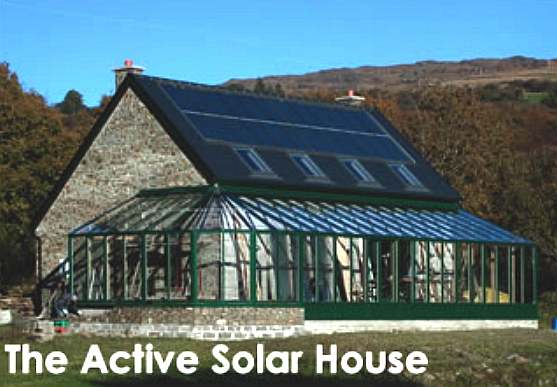
A
nicely integrated solar house
IS
FREE CENTRAL HEATING POSSIBLE?
That
all depends on the design of a house. The following example from Ireland
provides much data for a passively part heated house, using a solar
conservatory.
According
to an article on the Viking House website, the Glengariffe Passive Solar House has a South facing Conservatory that supplies 45% of the heating requirement for the house.
The
heat savings were monitored throughout an entire year (2005) with data
from more then 50 sensors being collected at five-minute intervals. The Active Solar House was used to study the effect of a sunspace (or conservatory) on the performance of the entire building.
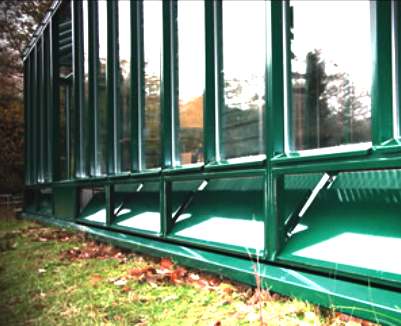
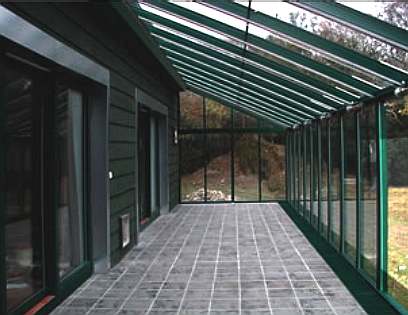
In order to absorb the maximum quantity of solar radiation, the flooring in the sunspace was covered with dark coloured tiles fixed to a 100mm concrete slab. The 250mm thick wall, separating sunspace from the main structure of the house, has also been painted in a dark colour, making it the main buffer and allowing little radiation to escape from the sunspace due to reflection.
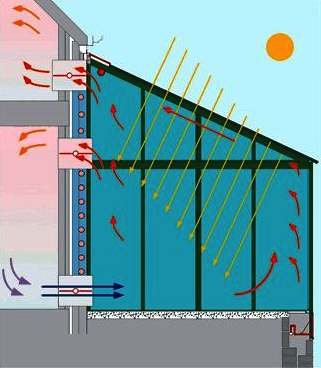
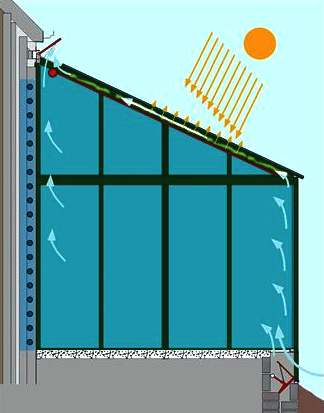
Connecting the main building to the sunspace with air ducts allows the integration of the passive behaviour of the sunspace and responds to solar heating by venting the warm air into the heating and air-conditioning system of the house. Its operational integration is achieved by communication between the control system of the sunspace and other control systems for heating in the house by the building management system.
RESULTS
Compensating for fluctuations in indoor temperature and using the actual recorded data for the ambient conditions, including the sunspace, the calculations show that, at a permanent indoor temperature of 19°C, the heating load would be 6,560 kWh for the year with a 31.4 % saving over the 9,564 kWh required if the sunspace was not fitted (All figures are gross figures, not taking into account other measures to reduce energy consumption, like active solar and heat pump).
A further 472 kWh was gained from air that was fanned from the sunspace, reducing the heat load to 6,088 kWh and producing a total saving of 36.3%.
It is expected that the figure for fanned air will improve, as software governing the devices has been tuned during the year. Mainly in the first six months of 2005 potential gains were lost, due to inadequate reaction to ambient conditions.
If heating load figures are brought in connection with the size of floor area and three quarters of the sunspace is considered living space (40 m2 / 4 * 3 = 30 m2), then the calculations show an even higher saving potential.
Without Sunspace: Heating load = 9,564 kWh Area = 170 m2 Heating load/m2 = 56.3 kWh/m2
With Sunspace fitted: Heating load = 6,088 kWh Area = 200 m2 Heating load/m2 = 30.44 kWh/m2 Saving on the heating load per m2 = 45.9 %
CONCLUSION
If constructed with good understanding of the thermodynamics involved, a sunspace can offer a range of benefits. It can be a very comfortable and desirable seasonal living space, whilst making an impressive contribution to the heating of the building and also supplying pre-heated air for internal ventilation. Moreover, it can create a buffer zone between living space and outdoor space that can be utilised for plant growth, whilst providing shading for the house in the summer time, and providing cooling in the summer time through controlled ventilation
However, several considerations need to be observed: the orientation of the sunspace, and good design with considerations for thermodynamics. Gains and losses should be calculated carefully before choosing a type of glass to be installed - translucency and insulation properties are often opposing factors with costs rapidly rising when trying for the ideal. The sunspace must not be heated, it must be possible to isolate the sunspace from the rest of the building, efficient controls must be installed, and the use of venting devices and a retractable blind system are absolutely vital.
Sunspaces are suitable for family homes as much as they are for larger and commercial buildings. The biggest obstacle to the introduction of sunspaces is lack of understanding of the subject of thermodynamics. This applies to the house builder or owner as well as to the industry.
Today many houses are built in Ireland with a conservatory. Many of these structures are great heat-losers, as little attention is paid to fundamental heating properties. This can be changed and, as was demonstrated in the experimental design, can be turned into a factor contributing to energy saving on a substantial scale.
So, not only are new technologies to be considered, it appears that there are also great potential gains in refining our methods of building. We may have to start getting used to the idea that long-standing traditional approaches in all aspects of energy consumption are slipping into the past, and try to look forward to the dawning post-fossil-fuel society.
CONTACTS
00353 + (0)87 655 8699
00353 + (0)1 445 6246
seamus@viking-house.ie
35 Hamilton Street, South Circular Road, Dublin 8
http://www.viking-house.ie/solar-house.html
Mike Jacob
Sunnypatch,
99 Waverley Road
Reading
RG30 2QB
Berkshire
01189 511 465
07863 119 698
email: mike.jacobs@viking-house.co.uk
JP McLaughlin
32 West Mill Road,
Edinburgh
Scotland
EH13 0NK
email: jp@viking-house.co.uk
Mob +44 (0) 754 9747 662
LL +4428 7776 4274
JP McLaughlin
3 Shackleton Drive
Ballykelly
Limavady
BT49 9RP
Donegal/N Ireland
email: jp@viking-house.co.uk
Mob +44 (0) 754 9747 662
LL +4428 7776 4274
Michael Patrick Donovan
25 Chevalier Grove
Crown Hill
Milton Keynes
MK8 0EJ
email: mike.donovan@viking-house.co.uk
Tel 01908 263 059
Mob 07770 943 510
ARCHAEOLOGY
- Well will you look at that. This is a brown-field site. Digging down
through the layers of earth, we struck backfill, clay where clay should
not have been, then two iron water pipes behind a brick wall (footings).
We also found glass by the bucket load. That means that there was a
building here plumbed into (supplied from) the well at the rear of the
building. We knew that anyway from studying old plans, but it's nice to
have confirmation.
|




